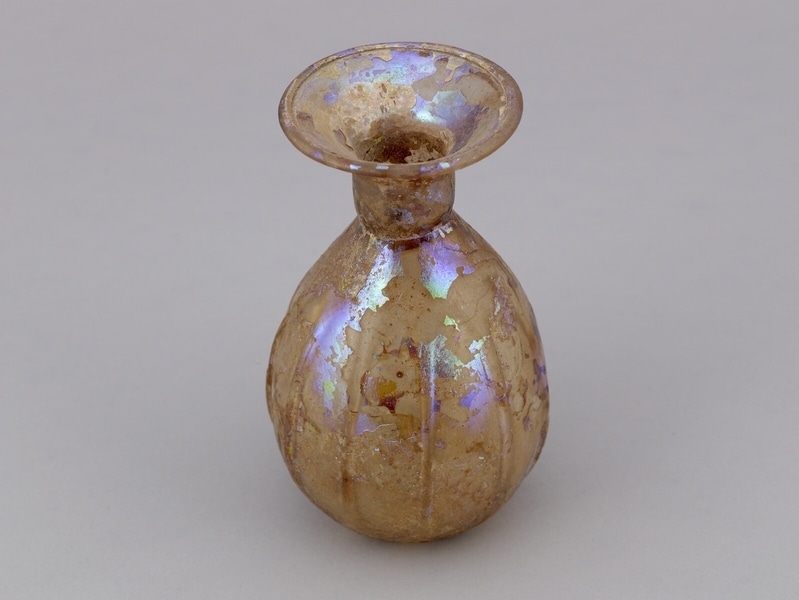Flask Item Number: M3.55 from the MOA: University of British Columbia


Description
Translucent honey-coloured flask. The body is pear-shaped body with a flat bottom. The neck is short and cylindrical. The mouth is wide but inside the neck is another, smaller opening. The rim is widely splayed and folded outwards, upward, and inwards. There are 12 pinched out vertical ribs on body from below shoulder to just above bottom.
History Of Use
Used to store unguents, oil or perfume.
Narrative
The van Haersolte Collection
Specific Techniques
The iridescence of ancient glass is symptomatic of the metal content. It is caused by exposure to damp earth or humid air over a long period of time. Carbon dioxide is dissolved in the moisture of the air of soil, forming carbonic acid. This in turn combines with the alkaline constituents of glass, bringing about decomposition of the surface. Glass which has been decolourized with manganese dioxide, such as this piece, displays more iridescence, coloured glass less. For comparative pieces see: Neuberg, pl.xx, fig. 70, c. and pl. xxv, fig. 84. No. 5.
Item History
- Made in Syria ? or Palestine ? between 1 and 300
- Collected during 1890
- Owned by Baron van Haersolte van den Doorn and Baron van Haersolte van den Doorn
- Owned by Kathleen van Haersolte van den Doorn before April 26, 1956
- Received from Leon & Thea Koerner Foundation (Funding source), U.B.C. President's Fund (Funding source) and Kathleen van Haersolte van den Doorn (Seller) on April 26, 1956
What
Who
- Culture
- Near East
- Previous Owner
- Baron van Haersolte van den Doorn, Baron van Haersolte van den Doorn and Kathleen van Haersolte van den Doorn
- Received from
- Leon & Thea Koerner Foundation (Funding source), U.B.C. President's Fund (Funding source) and Kathleen van Haersolte van den Doorn (Seller)
Where
- Holding Institution
- MOA: University of British Columbia
- Made in
- Syria ? or Palestine ?
When
- Creation Date
- between 1 and 300
- Collection Date
- during 1890
- Ownership Date
- before April 26, 1956
- Acquisition Date
- on April 26, 1956
Other
- Condition
- fair
- Current Location
- Case 96
- Accession Number
- 2308/0226